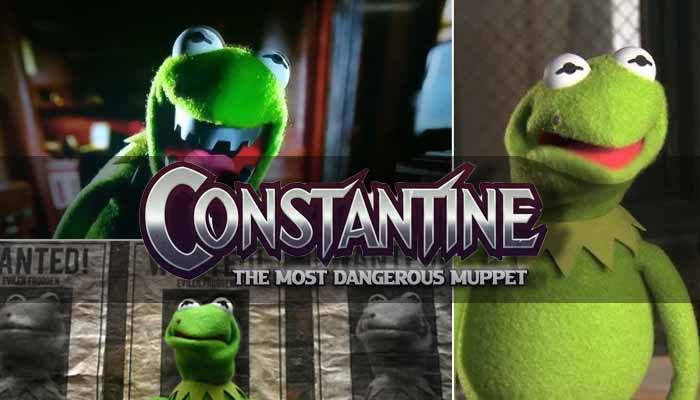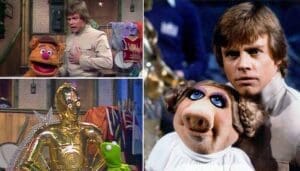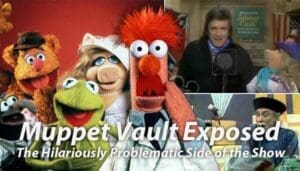Beyond Rainbow Connections – The Dark Side of the Muppets
The world of the Muppets is a delightful chaos, a whirlwind of felt, fur, feathers, and frantic energy, usually soundtracked by explosions, musical numbers, and the unwavering optimism of a certain green frog. It’s a universe built on dreams, showmanship, and the enduring power of friendship. But even in this vibrant landscape, shadows lurk. Villains emerge, often serving as foils to the Muppets’ ambitions, testing their unity and resolve. Traditionally, these antagonists have been human – greedy executives, ruthless restaurateurs, or jealous siblings standing between the Muppets and their goals. Figures like the menacing Doc Hopper, desperate to turn Kermit into a spokesfrog for fried frog legs , the charmingly deceitful Nicky Holiday plotting jewel heists , or the oil baron Tex Richman aiming to demolish their beloved theatre represent the typical external threats.
Then came Constantine. Bursting onto the scene (quite literally, out of a Siberian Gulag) in 2014’s Muppets Most Wanted, Constantine represented a new, more insidious kind of threat. Known as “The World’s Most Dangerous Frog” and the “Number One Criminal,” his most terrifying characteristic wasn’t just his penchant for explosives or martial arts; it was his uncanny resemblance to Kermit the Frog himself. This wasn’t just another human obstacle; this was a villain cut from the same cloth – or felt, rather – as the heroes. He posed a unique danger precisely because he was a Muppet, capable of infiltrating the group in a way no human antagonist ever could.
This raises a compelling question: What makes this evil amphibian tick? Is his reputation deserved? And considering the rogues’ gallery the Muppets have faced, could Constantine truly be the most evil villain in their universe? To answer that, we need to dissect the frog, examining his personality, his grand criminal scheme, his twisted relationships, and how he measures up against those who schemed before him.
Meet the Frog Behind the Menace: Deconstructing Constantine
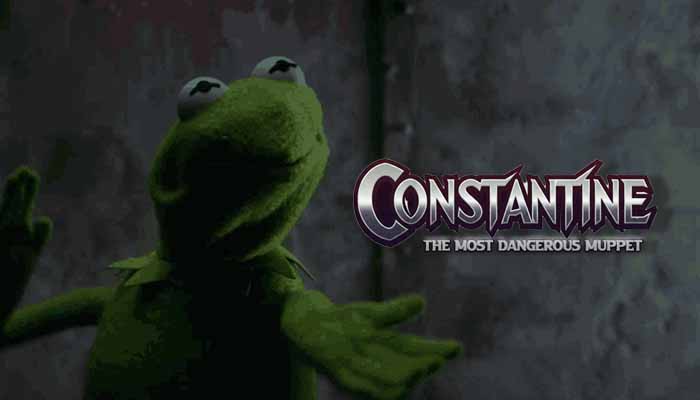
Personality – More Than Just a Mole
Constantine isn’t a villain born of circumstance or misunderstanding; he is explicitly, unapologetically evil. Described as an “Enjoyably Sadistic Doppelganger of Kermit,” he actively relishes his status as the “Number One” criminal. His villainy isn’t a burden; it’s a source of pride. When he declares, “It’s not easy being mean,” it’s delivered with a self-satisfied smirk, a twist on his counterpart’s famous lament, suggesting he enjoys the challenge. His ultimate goal isn’t just wealth, but infamy – to go down in history as the “Greatest Thief of All Time”. Constantine doesn’t just commit crimes; he seems to revel in the performance of being “The World’s Most Dangerous Frog”. His musical number “I’m Number One” isn’t just a boast; it’s a declaration of his villainous identity, a stark contrast to the greed-driven motives of predecessors like Doc Hopper. This performative aspect, this desire for recognition as evil, makes his motivations feel deeply tied to his ego and sense of self, fitting perfectly within the inherently theatrical Muppet universe.
Fueling this desire for infamy is a colossal arrogance. Constantine genuinely believes he is superior, particularly to his subordinate Dominic Badguy, whom he constantly reminds is “Number Two”. This supreme confidence allows him to undertake audacious plans, but it’s also a significant weakness. His ego makes him prone to errors, especially when attempting the difficult task of perfectly imitating Kermit’s mannerisms after studying old tapes.
Beneath the arrogance lies a cunning and manipulative mind. His plan to frame Kermit is executed with chilling speed and precision. Once inside the Muppet troupe, he employs subtle manipulation, exploiting the group’s gullibility and their individual desires for the spotlight to maintain his façade. He understands that allowing the Muppets creative freedom, however chaotic, will keep them distracted and compliant. Politeness is merely a tool, deployed only when strategically necessary to keep the Muppets on his side.
Despite his intelligence, Constantine exhibits notable shortcomings and hypocrisies. He dislikes being touched, yet has no issue invading others’ personal space, particularly Miss Piggy’s. His arrogance can also make him seem somewhat one-dimensional, an “evil mastermind type of doppelganger” whose primary function is to be mistaken for Kermit. While capable of projecting charm, it’s entirely superficial, masking a cold and calculating nature.
Skills & Talents – A Frog of Many (Dangerous) Talents
Constantine backs up his “World’s Most Dangerous Frog” title with a formidable skill set. His escape from a high-security Siberian Gulag showcases his competence in stealth, combat (“Let’s dance!” he challenges guards ), and, notably, explosives – he has a stated proclivity for “blowing things up”. This reputation for destruction makes the other Muppets genuinely fear him once his identity is revealed.
Ironically, for a master criminal focused on theft and infamy, Constantine also possesses genuine talent as a performer. His musical numbers, “I’m Number One” (with Dominic Badguy) and the surprisingly smooth “I’ll Get You What You Want (Cockatoo in Malibu)” (sung to woo Miss Piggy), demonstrate considerable singing and dancing abilities. This talent is crucial for his impersonation plot. However, it also presents a unique vulnerability. While a performer in his own right, Constantine initially buckles under the pressure of stepping into Kermit’s specific role, suffering severe stage fright during his first Muppet Show performance. This creates a fascinating paradox: the success of his elaborate criminal scheme hinges not just on his skills in burglary and manipulation, but on his ability to act like Kermit, the ultimate performer. His criminal prowess becomes almost secondary to the challenge of pulling off this impersonation within a group defined by performance, making his deception inherently fragile.
The Look and the Voice – Matt Vogel’s Mean Green
Visually, Constantine is Kermit’s near-perfect double. The primary distinguishing features are a prominent black mole on his right cheek (a key plot device) and a slightly shorter neck collar. This uncanny resemblance is the bedrock upon which his entire scheme is built, allowing him to slip into Kermit’s life with relative ease.
Bringing this sinister amphibian to life is Muppet performer Matt Vogel, who provides both the puppetry and the voice. Vogel’s performance has been praised for its “extremely charming and cartoony fashion,” successfully making Constantine both humorous and intimidating. Vogel imbues the character with depth, particularly evident in interviews where Constantine’s conceited and slightly dim off-stage persona shines through.
A crucial element of Vogel’s portrayal is Constantine’s voice. He employs a distinct, thick Russian-esque accent, immediately setting him apart from Kermit. His attempts to mimic Kermit’s iconic voice are intentionally flawed, becoming a running gag and a constant clue to his true identity. Lines like “Hi-lo! I am Kermit” and his disastrously accented rendition of “Rainbow Connection” – “Thee louvers, thee dreemers and chee-e-e-e-e-se! Nailed it.” – highlight the absurdity of the deception.
The casting of Matt Vogel adds an intriguing, almost unsettling, layer to the character, especially in hindsight. Vogel, the performer who brought Kermit’s evil doppelgänger to life, later took over the primary role of Kermit the Frog himself following Steve Whitmire’s departure. This creates a meta-narrative where the voice of the imposter became the voice of the original. Some audience members have even noted that Vogel’s Kermit occasionally echoes Constantine’s flawed imitation, a connection explicitly made in online fan discussions. Adding another twist, Constantine himself has been depicted in Muppet Wiki promotional material as resenting the popular “Evil Kermit” internet meme, which often features his image. This convergence of character, performer, and fan perception blurs the lines in a way perhaps only possible with the Muppets, lending an unexpected depth to Constantine’s legacy and the ongoing evolution of Kermit’s portrayal.
Crimes of a Criminal Mastermind (Allegedly): The Grand Heist
From Gulag to Grand Tour
Constantine’s master plan kicks off with a bang – literally. His explosive escape from the heavily guarded Siberian Gulag immediately establishes his credentials as a dangerous and capable operative. His first move upon tasting freedom is to eliminate his lookalike. The plan’s chilling efficiency is clear from the outset in Berlin. Under the guise of a friendly suggestion, Dominic Badguy sends Kermit for a walk, allowing Constantine to ambush him in the fog, swiftly glue a fake mole to his face, and vanish. This simple, brutal act instantly swaps their identities, sending the real Kermit to the Siberian Gulag Constantine just escaped, mistaken for the master criminal. With Kermit neutralized and Dominic already embedded as the Muppets’ new tour manager, Constantine seamlessly takes the frog’s place, ready to use the European tour as cover for his real objective. Dominic smooths over the initial awkwardness, attributing Constantine’s strange accent and behavior to a bad cold.
The Heist Trail – A Criminal Tour of Europe
With Constantine installed as the Muppets’ leader, the criminal tour begins. The modus operandi is consistent and cunning: Dominic books the Muppet Show into prestigious venues located conveniently adjacent to museums or banks housing specific artifacts Constantine needs. The performances serve as the perfect distraction for the heists.
- Berlin: While the Muppets perform (with Constantine overcoming initial stage fright), he and Dominic break through a wall into a neighboring museum, stealing several valuable paintings. Crucially, one seemingly worthless painting contains hidden instructions related to Thomas Blood, infamous for attempting to steal the Crown Jewels in the 17th century.
- Madrid: Following the instructions, the tour moves to Madrid. During another chaotic Muppet performance (fueled by Constantine letting the cast do whatever they want), the duo infiltrates the Museo del Prado. They smash numerous priceless busts until they find one containing a hidden key, another piece of the puzzle.
- Dublin: The key leads them to Dublin. While Constantine proposes to Miss Piggy on stage to create a diversion and secure a future location, Dominic breaks into the Bank of Ireland and steals Blood’s locket.
With each successful robbery, Interpol agent Jean Pierre Napoleon and CIA agent Sam Eagle are left baffled, initially suspecting the elusive “Lemur” (Dominic’s criminal alter ego) before realizing the Muppet tour strangely coincides with the crimes. However, their interrogation of the Muppets leads them to conclude the performers are simply too dimwitted to pull off such elaborate thefts. Constantine’s plan to use the Muppets as unwitting accomplices and eventual scapegoats appears to be working perfectly.
The Crown Jewel – Ultimate Goal and Ruthlessness
The ultimate prize, the target driving this elaborate European caper, is the Crown Jewels of England, housed securely in the Tower of London. Stealing them isn’t just about monetary value; it’s about cementing Constantine’s legacy as the “Greatest Thief of All Time”.
Constantine displays consistent ruthlessness throughout his scheme. He manipulates his “friends,” frames his doppelgänger, and plans to leave the entire Muppet troupe to rot in prison for his crimes. When cornered by Fozzie and Walter after they discover his identity, his immediate reaction is violence, threatening Fozzie with the chilling line, “You have wocka-ed your last wocka, bear”. During the climax at the Tower of London, he doesn’t hesitate to take Miss Piggy hostage to secure his escape.
Some sources, particularly fan wikis, claim Constantine is willing to commit “mass murder”. While his actions are certainly dangerous – he uses explosives, threatens Muppets, and takes hostages – the narrative presented in the film’s plot summaries does not depict him actually attempting or committing mass murder. His plan involves pinning the blame, not annihilation. This specific claim appears to be an exaggeration not directly supported by the film’s events. Constantine’s actions escalate significantly, showcasing his willingness to endanger others for his goals. However, within the established framework of a PG-rated Muppet movie , his villainy stops short of the explicit, lethal actions the “mass murder” claim implies. His evil manifests through betrayal, manipulation, and endangerment rather than outright killing of main characters, maintaining a certain boundary appropriate for the franchise. He’s menacing, but his evil is calibrated for the Muppet world.
It Takes Two (To Cause Trouble): Constantine and Number Two
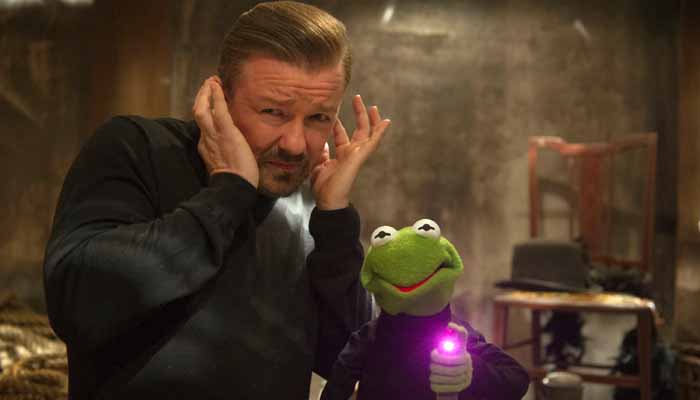
Constantine doesn’t operate entirely alone. His partner in crime is Dominic Badguy, played by Ricky Gervais, who serves as his subordinate, accomplice, and perpetually designated “Number Two”. Their relationship is far from equal. Constantine lords his “Number One” status over Dominic, frequently belittling him and demanding subservience.
This toxic dynamic is perfectly encapsulated in their duet, “I’m Number One,” and Constantine’s dismissive remarks. He tells Dominic his name will appear on the annals of crime history only after Constantine’s name followed by “spacebar, spacebar, spacebar”. He commands Dominic to “Dance, monkey, dance!” reducing him to mere entertainment. This constant assertion of dominance fuels Constantine’s ego but also breeds resentment in Dominic.
Despite the mistreatment, Dominic plays an indispensable role. Posing as a legitimate international tour manager, he provides the crucial cover story, infiltrates the Muppets’ operation, and handles the logistics of the tour and the heists. There are hints that Dominic might possess more intelligence or cunning than Constantine gives him credit for, perhaps harboring smarter plans that are stifled by Constantine’s overbearing leadership. This aligns with advice given to past Muppet villains: “Look Out for Number Two,” as henchmen in these stories often have a change of heart or harbor secret ambitions.
Indeed, Dominic eventually attempts a double-cross during the final confrontation at the Tower of London. He reveals his own criminal identity – “The Lemur,” the world’s second most wanted criminal – and tries to seize the Crown Jewels for himself. However, the attempt is laughably inept. Constantine, utterly unimpressed, mocks the “worst bad guy name” he’s ever heard and easily foils the betrayal, ejecting Dominic from the escape helicopter while lecturing him on the basics of treachery: “First rule of double-cross. You don’t announce the double-cross before you double-cross. It’s not even a rule because it is so obvious”. Their partnership, built on ego and mistreatment, proves inherently dysfunctional. Constantine’s arrogance makes him oblivious to the depth of Dominic’s resentment, while Dominic’s ambition outstrips his competence when he finally makes his move. This dark comedy reinforces Constantine’s dominance but also showcases the instability and slight ineptitude that often characterizes even villainy in the Muppets’ chaotic world.
The Evil Twin vs. The Icon: Impersonating Kermit
Walking a Mile in Green Felt Shoes
Constantine’s greatest challenge isn’t cracking safes or dodging Interpol; it’s convincingly playing the part of Kermit the Frog. He diligently studies old tapes of The Muppet Show , but the impersonation proves difficult. His thick accent constantly bleeds through, he lacks Kermit’s inherent warmth and leadership qualities, and, as mentioned, he suffers from crippling stage fright, initially fainting during his first performance. His attempts at Kermit’s catchphrases and signature moments are comically bad, from the stiff “Hi-lo! I am Kermit” greeting to his mangled attempt at “Rainbow Connection”.
Despite the glaringly obvious flaws in his performance, Constantine manages to fool the majority of the Muppets for a surprisingly long time. After realizing he can’t truly mimic Kermit’s personality, he stumbles upon a different, highly effective strategy: appeasement. He abandons Kermit’s structured, often stressful, approach to show planning and simply allows the Muppets to indulge their wildest performance desires. Gonzo wants an indoor running of the bulls? “Sure, Zongo. Who cares?”. Miss Piggy wants to sing five songs instead of one? “You can. Who cares?”. This laissez-faire attitude leads to increasingly chaotic and lengthy shows, but it effectively buys the Muppets’ loyalty and keeps them too preoccupied to notice the frog in charge isn’t their frog. Only Animal remains consistently suspicious, growling “Bad frog!” , while Walter and Fozzie eventually piece together the truth. The Muppets’ own desire for creative expression and the spotlight becomes their blind spot. Constantine, unable to replicate Kermit’s genuine leadership, successfully manipulates them by simply giving them what they want, demonstrating how unchecked individual ambition can make a group vulnerable, even when the manipulator is poorly disguised. This highlights the often-underappreciated importance of Kermit’s role in maintaining order amidst the Muppet chaos.
Piggy Problems – A Frog He Can’t Stand
While Constantine manages to fool most of the Muppets, his relationship with Miss Piggy is particularly strained – at least from his perspective. He finds her affectionate advances appalling and is clearly repulsed by her presence. His irritation boils over in moments like his exasperated query, “Pig, I have question. Am I wearing sign that says ‘BOTHER ME’?!”.
Yet, blinded by her own desires for marriage and affection from “Kermie,” Miss Piggy largely buys Constantine’s act, despite his awkwardness and lack of genuine warmth. Constantine even uses her desires against her, proposing marriage as part of his scheme to secure the Tower of London as the location for the final heist.
Ultimately, however, Piggy’s fierce loyalty to the real Kermit proves crucial to Constantine’s downfall. When the truth is revealed during the wedding ceremony, her rage is spectacular. Her declaration – “NO! ONE! TRICKS! ME! INTO! MARRYING! THEM! AND! THEN! HURTS! MY! KERMIE!” – is punctuated by a furious karate assault that incapacitates the master criminal. Even in defeat, Constantine seems grudgingly impressed, muttering, “What a woman”.
Rogues Gallery Rumble: Constantine vs. The Humans
Setting the Stage – The Usual Suspects
To truly gauge Constantine’s villainy, he must be measured against his predecessors. As established, Muppet movie antagonists are typically human outsiders threatening the group’s existence or dreams. Let’s revisit the key contenders:
- Doc Hopper (The Muppet Movie): This fast-food entrepreneur relentlessly pursued Kermit, wanting him as the face (and legs) of his fried frog legs chain. His methods escalated from persuasion to threats, attempted brainwashing via a bizarre machine, and ultimately hiring a professional frog killer named Snake Walker. Driven purely by greed and business ambition, Hopper’s willingness to harm Kermit makes him a genuinely dark figure in the Muppet canon, often ranked highly by fans for his ruthlessness.
- Nicky Holiday (The Great Muppet Caper): The suave but treacherous brother of fashion designer Lady Holiday, Nicky orchestrated jewel heists, culminating in a plot to steal the fabulous Baseball Diamond. He used his charm to manipulate situations and people (including an uncomfortable fixation on Miss Piggy), framed Piggy for his crimes, and even took Kermit hostage at gunpoint. His motivations stemmed from greed and jealousy towards his successful sister. While charismatic, his actions revealed a cruel streak beneath the surface.
- Tex Richman (The Muppets): An oil tycoon scheming to buy and demolish the Muppet Theater to access the oil reserves beneath it. Richman used deception and legal loopholes, attempted to sabotage the Muppets’ fundraising telethon, and famously suffered from an inability to laugh, forcing him to instruct his henchmen to perform a “Maniacal laugh”. His primary motivation was greed, though a deleted backstory suggested a childhood grudge against the Muppets. His defeat was fittingly absurd – a bowling ball to the head induced laughter and a change of heart.
The Comparative Analysis – What Makes Constantine Different?
Constantine stands apart from these human adversaries in several key ways. Firstly, and most significantly, he is a Muppet. This grants him an unprecedented advantage – the ability to infiltrate the group, gain their trust (however superficially), and manipulate them from within. His evil feels less like an external attack and more like an internal betrayal, a violation by one of their own kind.
Secondly, his primary motivation differs. While Hopper, Holiday, and Richman were all driven fundamentally by greed – for money, resources, or business success – Constantine’s engine appears to be his ego and a thirst for criminal notoriety. Stealing the Crown Jewels is less about the monetary value and more about achieving legendary status as the “Greatest Thief of All Time.” The crime itself is almost secondary to the reputation it will bring.
Thirdly, the scale and methodology of his plan are arguably more ambitious and intricate. His operation spans multiple European countries, involves carefully planned heists targeting specific historical artifacts, and relies heavily on psychological manipulation and direct impersonation of the group’s leader.
Evaluating the “evil” quotient requires considering what constitutes true villainy within the Muppet context. Is it the direct, visceral threat of physical harm posed by Doc Hopper wanting to literally cook Kermit? Is it the attempt to erase the Muppets’ legacy and home, as Tex Richman planned? Or is it the intimate, calculated betrayal perpetrated by Constantine, who weaponizes Kermit’s identity and the Muppets’ own trusting nature against them? Constantine’s evil feels particularly insidious due to his insider status and his motivation being rooted in a narcissistic desire to be the best at being bad, rather than a specific tangible gain. This forces a re-evaluation of Muppet villainy, suggesting that the deepest violation might come not from external greed, but from internal corruption of identity and trust.
Villain Comparison Table
To clarify these distinctions, here’s a comparative overview:
| Villain | Type | Main Goal | Key Evil Actions | Primary Motivation | Unique Trait/Weakness |
|---|---|---|---|---|---|
| Doc Hopper | Human | Make Kermit spokesfrog | Relentless pursuit, threats, attempted brainwashing, hired frog killer | Greed/Business | Single-minded obsession |
| Nicky Holiday | Human | Steal Baseball Diamond | Jewel theft, framing Miss Piggy, manipulation, hostage-taking | Greed/Jealousy | Charm hiding insecurity |
| Tex Richman | Human | Drill for oil under theater | Deception, attempted legacy destruction, sabotage | Greed/Revenge(?) | Inability to laugh |
| Constantine | Muppet | Steal Crown Jewels / Infamy | Framing Kermit, manipulation, multiple heists, hostage, betrayal | Ego/Criminality | Arrogance / Poor Impersonator |
The Verdict on the World’s Most Dangerous Frog
Constantine emerges from the analysis as a uniquely compelling figure in the Muppets’ rogues’ gallery. His inherent evil, sophisticated manipulation skills, ambitious international crime spree, and, above all, his status as a Muppet doppelgänger set him apart. Driven by a desire for legendary criminal infamy rather than simple greed, he represents a different flavor of antagonism.
So, is he the “most evil”? The term itself is subjective, especially in a universe known for its absurdity. Doc Hopper’s plan to turn Kermit into fast food carries a particularly grim undertone. Tex Richman’s attempt to obliterate the Muppets’ history and home strikes at their very core. Yet, Constantine’s calculated betrayal from within, his cold manipulation of trust and identity, and his ego-fueled pursuit of villainy for its own sake present a strong case. His evil feels less reactive and more fundamental to his character, arguably making him the most complex and perhaps the most insidiously evil foe the Muppets have encountered. He didn’t just want to stop them or take something from them; he wanted to be them, twist their world to his advantage, and achieve glory through their downfall.
Regardless of where he ranks on the “evil” scale, Constantine left an indelible mark. He proved to be a memorable, genuinely threatening, yet hilariously entertaining villain, fitting remarkably well into the Muppets’ unique blend of chaos and heart. Matt Vogel’s masterful performance cemented him as a standout character, a villain who was both larger than life and disturbingly familiar. Whether the absolute “most evil” or not, Constantine certainly demonstrated that while it might not be easy being green, it’s definitely not easy being mean – especially when you’re aiming for Number One.

